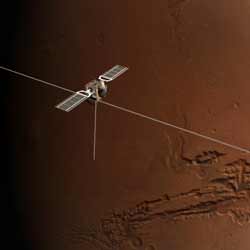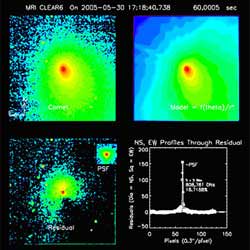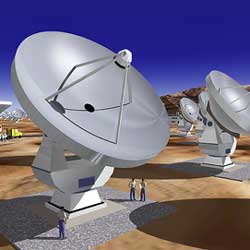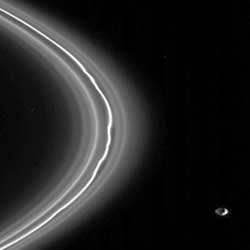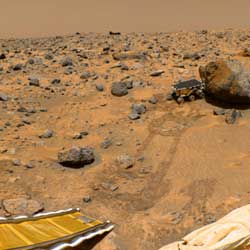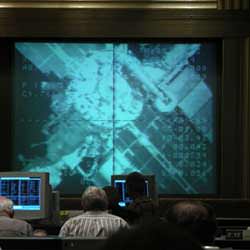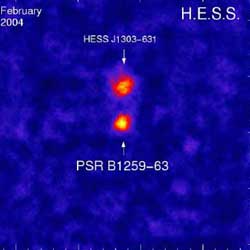
HESS image of binary pair PSR B-1259-63 / SS 2883. Image credit: HESS. Click to enlarge.
Binary pair PSR B-1259-63 / SS 2883 is located some 5,000 light-years distant in the general direction of the southern hemisphere constellation Crux (the Southern Cross). The duo consists of a pulsar (PSR B-1259) and massive blue giant (SS 2883) locked into a widely-swinging dance that repeats steps every 3.4 years. The pulsar?s orbit of the more massive primary is so eccentric that the pair passes within 100 million kilometers at closest approach and they separate roughly ten times that distance at their furthest point. During closest approach, signals from the pulsar drop off significantly as it is eclipsed by the massive blue giant.
Observers using the 12.5 metre High Energy Stereoscopic System (HESS) recorded the pair’s dance during moonless nights from February through April 2004, and timed them as the pulsar approached and receded from the duo’s closest point. The astronomers found that radio waves from the pulsar matched up with ultra-high gamma radiation coming from the region.
According to Felix Aharonian of the Max Plank Institute for Nuclear Physics, Heidelberg Germany, this binary system “allows ‘on-line watch’ of the extremely complex MHD (magnetohydrodynamic) processes of creation and termination of the ultrarelativistic pulsar wind, as well as particle acceleration by relativistic shock waves, through the study of spectral and temporal characteristics of the high energy gamma-radiation of the system. In this regard the binary system PSR B1259-63 is a unique laboratory to explore the physics of the pulsar winds.”
The pulsar was first detected by a team of astronomers in 1992 using the Parkes radio telescope in Australia. Its magnetic jet orients toward the Earth 20 times a second. In addition to radio emission, the pulsar broadcasts X-rays – at various energy levels – throughout its orbit. These X-rays are thought to be the result of radiation that occurs when the pulsar’s magnetic field interacts with gases released by the companion blue giant.
The blue giant SS 2883 was first discovered to be a companion with the pulsar in 1992. It’s ten times the mass of the Sun, but has high temperatures and a rapidly burning fusion engine. It rotates very quickly and ejects material from its equator on a sporadic basis. According to the paper ‘Discovery of the Binary Pulsar PSR B-1259-63 … with H.E.S.S.’, “Be stars are known to have non-isotropic stellar winds forming an equatorial disk with enhanced mass outflow.”
The paper goes on to say that “timing measurements suggest that the disk is inclined with respect to the orbital plane…” such an orbital inclination causes the “pulsar to cross the disk two times near periastron.” And it is at these crossings that things really get souped up as the pulsar’s magnetic field begins to interact with charged particles in the reverse shock region of the stellar ejecta.
As a result, this system is said to be a ‘binary plerion’ where “The intense photon field provided by the companion star not only plays an important role in the cooling of relativistic electrons but also serves as the perfect target for the production of high-energy gamma rays through inverse Compton (IC) scattering.” Felix expands on this notion by saying that “the pulsar is not isolated, but located in a binary system close to a powerful optical star. In this case, because of interaction with the stellar wind under high gas pressure, the pulsar wind terminates within the binary system where the magnetic field is quite high (approximately 1 G, i.e. 10,000 to 100,000 times larger than in standard plerions). Furthermore, because of the optical star’s presence, the electrons suffer severe losses during interactions (Compton scattering) with starlight. This makes the lifetime of electrons very short, 1 hour or less. High energy gamma-rays can be produced also by interactions of electrons (and perhaps also protons) with the dense gas of the stellar disk (also on quite short timescales!).”
As a binary plerion, the star system displays a wide-ranging energy signature based on the pulsar’s eccentric orbit and broad variations in the density of circumstellar matter around SS 2883 with which it interacts. Near periastron, The “cold” pulsar wind interacting with the ambient plasma, terminates with the creation of a relativistic shock wave which in turn accelerate particles to extremely high energies, 1 TeV or more. Heat in these particles is then ‘cooled’ as photons strike fast-moving electrons and positrons. This inverse Compton scattering effect carries off energy by amplifying photon frequencies wildly. Simply said, photons of low-energy “visible light” are boosted to much higher energy levels – some achieving the terra-electron volt region of the upper gamma ray / lower cosmic ray domain.
Meanwhile as the pulsar moves away from the stellar primary, it encounters fewer and fewer charged particles, meanwhile the density of visible light photons from the central star also falls off. As this occurs, scattering of photons is reduced and synchrotron radiation begins to dominate. Because of this, lower power-level X-rays begin to dominate the energy signature of the system as the pulsar slows and moves away from the star.
Finally, there are two periods in the pulsars orbit where it crosses the equatorial plane of the blue giant’s circumstellar disk. These transition points can result in the creation of numerous super-energized photons, electrons, positrons and even some protons. As relativistically accelerated particles are created, they in turn interact with a region able to spawn a multitude of other particles capable of breaking down into high-energy photons and other particles.
From the paper published June 13, 2005, “Up to now the theoretical understanding of this complex system, involving pulsar and stellar winds interacting with each other is quite limited because of the lack of constraining observations.” But now because of IACTS (Imaging Atmospheric Cherenkov Telescopes) such as H.E.S.S., astronomers are now able to resolve many new near-point sources of high energy gamma rays from other systems such as PSR B-1259-63 / SS 2883.
In the PSR B-1259-63 / SS 2883 system, nature seems to have provided astronomers – and physicists – with her very own version of a super-high energy particle accelerator – one that is thankfully well contained and a safe distance from Earth.
Written by Jeff Barbour

